The Republic of Uzbekistan
General Data
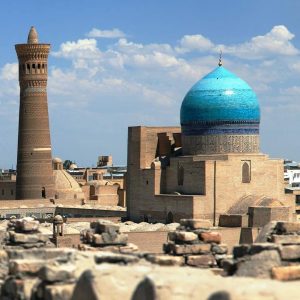 Uzbekistan – A Profile
Uzbekistan – A Profile
Formal name: The Republic of Uzbekistan
Geographic coordinates: 41 N, 64 E
Area: total 448,9 thousand sq.km
Land boundaries: total 6,221 km border countries: Afghanistan 137 km, Kazakhstan 2,203 km, Kyrgyzstan 1,099 km, Tajikistan 1,161 km, Turkmenistan 1,621 km
Population: 30 million
Density of population: 49 per km2
Capital: Tashkent
Official Language: Uzbek. Widely used: Russian and Karakalpak. English is popular among young generation.
National currency: Sum (1 sum=100 tiyin)
Structure: Autonomous Republic of Karakalpakistan, 12 provinces, 226 cities and districts.
Religion: Islam, 88%; Christianity, 9%
Time: GMT + 05:00
Electric power: 220 VAC, 5A; standard two-pin plug socket (equivalent to Europe)
Domain zone: .uz
International dialing code: +998
Geography
The Republic of Uzbekistan is situated in the central part of Central Asia between two rivers: the Amudarya and Syrdarya. The Turan Lowland lies to the northwest, and the Tien-Shan and Pamir-Alay mountain ranges are located in the southeast of the territory. The Kyzyl Kum Desert defines the northern part of the country.
Five states are its neighbors: Afghanistan in the south, Kazakhstan in the north and northwest, Kyrgyzstan in the northeast, Turkmenistan in the southwest, and Tajikistan in the southeast.
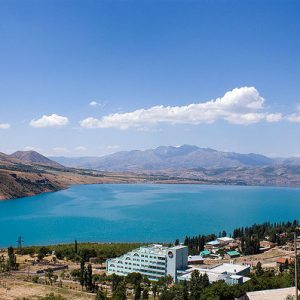 Weather
Weather
The climate in the Republic of Uzbekistan is continental, with mild winters and long hot summers.
The northern part of country is temperate, but the far southern part falls into the sub-torrid zone, where drought, an abundance of heat and light, and a high sun during parts of the year are inherent features. The coldest month is January. The average temperature in December is –8°С in the north, and 0°С in the south, though temperatures in the north can reach –25°С and lower.
The hottest month is July. The average temperature in summer exceeds 35°С, but on certain days, temperatures may reach 45°С and higher. The most pleasant time for visiting Uzbekistan is spring, from March to early June, and Autumn, from September to early November.
National Cuisine
Uzbek cuisine cannot be described, it has to be tasted. Fruits and vegetables grown under the tender oriental sun are prominent. There are about 100 varieties of Uzbek plov, the national dish. Plov is often made with meat, rice, onions, and carrots, though it is prepared in a different way in every region. In all, there are over one thousand dishes in Uzbek cuisine.
Public Holidays
January 1 – New Year
March 8 – Women’s Day
March 21 – Navruz
May 9 – Memorial Day
September 1 – Independence Day
October 1 – Teacher’s Day
December 8 – Constitution Day
Religious Holidays with varying dates: Ramadan Khait, Kurban Khait
History
Uzbekistan’s rich history dates back millennia. The Central Asian region has been inhabited by humans for over 1 million years. During the last half a century, scientists have uncovered several Stone Age settlements. Particularly famous are the ancient Kulbulak and Obi Rakhmon settlements, as well as Teshiktash and Amankutan. Productive lands, good water sources, and an abundance of heat contributed to the development of farming.
Large areas of desert and steppe near farming districts served as the pastures for cattle. With their evolution the inhabitants of these regions established various relations with neighbors. Based on the trinity of geographical, economic, and social factors, ancient states like Sogdiana, Bactria, Khorezm, and others formed.
The Ancient Orient
Almost continuous wars took place between the states of the ancient Orient. Their goal was to conquer other lands for slaves and other valuable items. Rich resources of the region, and its geographical position drew the attention of numerous occupants. In the second half of the first millennium b.c., the states situated on the territory of contemporary Uzbekistan were conquered by Akhemenid kings and were included in the huge Akhemenid Empire as eastern possessions.
In 329-327 b.c., Uzbek lands entered into Empire of the Alexander of Macedonia, who married to Roxana, the daughter of Oxiarth, the ruler of Sogdiana, and after his death – into the State of Seleucids. Later they joined the Greek-Bactrian Kingdom and Kushan Empires.
In the 6th century a.d. these Central Asia states included in the Turkic Kaganate that united various tribes in the region. Later they joined the Greek-Bactrian Kingdom and Kushan Empires. In the 6th century a.d. these Central Asia states included in the Turkic Kaganate that united various tribes in the region.
As a result of constant occupation, periods of economic and cultural prosperity were interchanged with eras of deep recession. However, the development process continued and the Great Silk Road that connected Rome and China contributed to this in many ways. Historical chronicles credit the Chinese emperor with the idea of laying this unique transcontinental road, after a Chinese courier returned home in 125 b.c. to report that beyond the Great Chinese Wall, and the seemingly unlimited steppes and deserts, there were powerful states such as Khorezm, Sogdiana, and others with a highly developed and unique culture.
In the early 7th century, Arabs intruded the territory of this region. The period of Samanid rule was marked by prosperity of cities that turned into large centers of international trade and culture. Then this land was occupied and governed by the dynasties of Gaznevids, KaraKhanids, and Seldjuks.
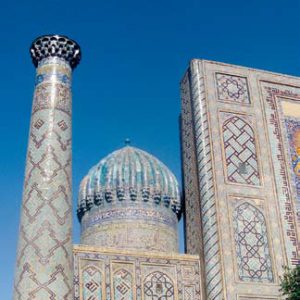 Early Uzbekistan
Early Uzbekistan
According to the scientists, the process of national formation in the territory that is now Uzbekistan dates back to around 1000 b.c. This process was lengthy. However, the term “Uzbek” was introduced in the 15th and 16th centuries a.d., during the period of Shaibani Khan’s rule.
Amir Temur, an ancient ruler and national hero, became one of the main influences on statehood in this region. In the second half of the 14th century, taking advantage of the disintegration of the states of Chengiz Khan’s heirs in Central Asia, Amir Temur united them and founded a powerful state with capital in Samarkand. In 1380 Amir Temur made military marches to other countries, conquering Iran, the Caucasus, Iraq, Syria, Turkey, and Northern India.
The establishment of a centralized state called Movaroun-Nahr in Central Asia, and the elimination of fractures, created favorable conditions for the development of an economy that had previously been exhausted by the rule of Mongols. Due to Amir Temur’s political energy, state, social, and military governance improved substantially.
The Temuridsz
Science, architecture, urban construction, literature, painting, and applied arts thrived under the rule of Temur and his heirs, and were represented in the large empire. For instance, Temur’s famous grandson, Ulugbek, ruled a state very near to the contemporary Uzbekistan. Ulugbek was not only a statesman, but a student of world history, an outstanding scientist, and an organizer and patron of science and arts. He founded an astronomical observatory unparalleled for its time.
Nowadays, the names of great statesmen, scientists, philosophers, and poets whose achievements were included in the jewel box of the world civilization are well known in many countries. Among them is Abu Ali bin Sino (Avicenna) who, with Hippocrates, is considered as the founder of modern medicine; mathematician al-Khorezmi whose treatise, “Rules of Reintegration and Reduction” introduced Arabic numerals to the west; astronomer Ulugbek who make astronomy a science. This list is added by Sunni scholars Bahouddin Nakshband, Al-Bukhari, At-Termizi, scientist Abu RayKhan Beruni, poet Alished Navoi and many others. Wonderful palaces, mausoleums, madrassas, and minarets created during the Temurid era still amaze tourists with their grandness.
Samarkand, Bukhara, Khiva, and Shahrisabz, which are included in the World Heritage
List by UNESCO, are deemed jewels of history. After a recession during the occupation of this land by Shaibani Khan, development of civilizations like the Bukhara, Kokand, and Khiva Khanates emerged.
Soviet Period
Indeed, neighboring Russia could not ignore this geopolitically important region, since it held great economic opportunities for Russia. Russia was interested in agricultural products like cotton and leather. Handcrafters’ products were still famous for their wonderful quality and perfect finish. In late 1840s and early 1850s, the gradual occupation of the region’s territories by the Russian empire. In 1867 the Turkestan province, with center in Tashkent, was established.
The period after the October Revolution in Russini 1917 became another page in Uzbekistan’s history. Soviet rule was declared in Turkestan in 1918. In 1924, as a result of national and state demarcation, the Uzbek Soviet Socialist Republic was established and included in the USSR.
Independence
Uzbekistan declared its independence from the USSR on August 31, 1991 at the extraordinary session of the Supreme Council of the country. On March 2, 1992 Uzbekistan joined the United Nations Organizations as equal member, and joined the Helsinki process by signing the Final Act of the Summit for Security and Cooperation.
Today, independent Uzbekistan is also member of leading economic and financial organizations such as the World Bank, Asian Development Bank, Islamic Development Bank and a number of other prestigious international organizations.
The interest of partners in developing relationships with Uzbekistan is explained not only by the great potential of Uzbekistan’s natural resources, but also by the effectiveness of its economic policy.
Political Structure
President of Uzbekistan
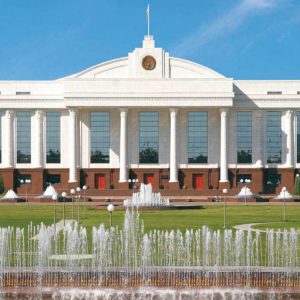 The President of the Republic of Uzbekistan is the head of the state and is responsible for coordinated operations and interaction of bodies of State power. The President of the Republic of Uzbekistan is the highest official and the Supreme Commander-in-Chief of the Armed Forces of the Republic of Uzbekistan. His powers are defined by the special section of the Constitution of the Republic of Uzbekistan. Under the Constitution and for the purpose of enforcement of the Constitution and laws of the Republic of Uzbekistan, The President of the Republic of Uzbekistan issues decrees, resolutions and orders.
The President of the Republic of Uzbekistan is the head of the state and is responsible for coordinated operations and interaction of bodies of State power. The President of the Republic of Uzbekistan is the highest official and the Supreme Commander-in-Chief of the Armed Forces of the Republic of Uzbekistan. His powers are defined by the special section of the Constitution of the Republic of Uzbekistan. Under the Constitution and for the purpose of enforcement of the Constitution and laws of the Republic of Uzbekistan, The President of the Republic of Uzbekistan issues decrees, resolutions and orders.
A citizen of the Republic of Uzbekistan not younger thirty five, being in full command of the national language and permanently residing on the territory of Uzbekistan for at least 10 years, immediately preceding the elections, may be elected the President of the Republic of Uzbekistan. One and the same person may not be the President of the Republic of Uzbekistan for more than two consecutive terms. Political parties and citizens can nominate a candidate for the President of the Republic of Uzbekistan. A political party can nominate a candidate for the President of the Republic of Uzbekistan, provided that its registration with the Ministry of Justice no later than six months prior to the announcement of the election campaign.
Every citizen or a group of citizens eligible to vote can form an initiative group of voters, consisting of not less than three hundred voters to nominate a candidate for the President of the Republic of Uzbekistan. Nomination of candidates for the President of the Republic of Uzbekistan starts sixty-five days before the election and ends forty-five days before the election. Nomination of candidates for the President of the Republic of Uzbekistan is performed by the highest bodies of political parties or a meeting of the initiative group of voters. A supreme body of the political party, initiative group of voters can nominate one candidate for the President of the Republic of Uzbekistan.
A political party is entitled to nominate a candidate for President of Uzbekistan only from the members of the party or from non-party, and an initiative group of voters can nominate a candidate for the President of the Republic of Uzbekistan, provided that he/she is not a member of any political party. The candidate may agree to run only for one initiative group of voters. The President of the Republic of Uzbekistan is elected by the citizens of the Republic of Uzbekistan on the basis of general, equal and direct suffrage by a secret ballot for the term of seven years.
On December 5, 2011 the Senate of Uzbekistan adopted a law on amendments to the Article 90 of the Constitution of the Republic of Uzbekistan, providing for the reduction of presidential powers from seven to five years.
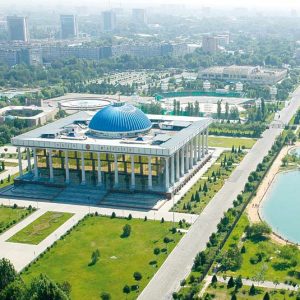 Oliy Majlis of the Republic of Uzbekistan
Oliy Majlis of the Republic of Uzbekistan
The Oliy Majlis of the Republic of Uzbekistan is the supreme state representative body that exercises legislative power and consists of two chambers – the Senate (Upper chamber) and the Legislative Chamber (Lower chamber).
The Senate of the Republic of Uzbekistan is the chamber of territorial representation and consists of one hundred members of the Senate (senators).
Members of the Senate of the Oliy Majlis of the Republic of Uzbekistan are elected in equal quantity, in six persons, from the Republic of Karakalpakstan, regions and the city of Tashkent by secret ballot at appropriate sessions of deputies of Zhokarghy Kenes of the Republic of Karakalpakstan, representative bodies of state authority of regions, districts and cities from among these deputies. Sixteen members of the Senate of the Oliy Majlis of the Republic of Uzbekistan are appointed by the President of the Republic of Uzbekistan from among the most respected citizens with large practical experience and special merits in science, art, literature, manufacture and other spheres of state and public activity. The term of office for the Senate is five years.
A member of the Senate may be a citizen of the Republic of Uzbekistan who has reached on the date of the elections twenty five years of age and permanently residing on the territory of the Republic of Uzbekistan not less than five years. The Senate adopts decisions on matters relating to organization of its works and the internal schedule of the chamber. The Senate may make statements and addresses on political, social and economic issues; these statements are addresses are formalized as resolutions of the Chamber Sessions of the Senate is the organizational format of its work activity. Senate sessions are convoked as required, but not less than three times a year.
The joint sessions of the Senate and the Legislative Chamber are convoked when the President of the Republic of Uzbekistan takes the oaths, makes speeches on major matters of social and economic life, government domestic and international policy, or when other countries’ leaders speak. As agreed by the chambers, the joint sessions of the chambers may be convoked on other matters. The Legislative Chamber of the Oliy Majlis of the Republic of Uzbekistan consists of one hundred fifty deputies. One hundred thirty five deputies of the Legislative Chamber are elected on the basis of the general, equal and direct suffrage by secret ballot in single-member territorial constituencies on a multiparty basis.
Fifteen members of the Legislative Chamber are elected from the Ecological Movement of Uzbekistan.
The work of the Legislative Chamber is based on the professional and permanent operations of all members of the chamber. The procedure for elections to the Legislative Chamber is stipulated by the Law of the Republic of Uzbekistan “On elections to the Oliy Majlis of the Republic of Uzbekistan” and other legislative acts. The term of office for the Legislative Chamber is five years. After expiry of its terms of powers, the Legislative Chamber continues its activity until the beginning of the work of the Legislative Chamber of new convocation.
A deputy of the Legislative Chamber may be a citizen of the Republic of Uzbekistan who has reached, on the date of the elections, the age of twenty five and is permanently residing on the territory of the Republic of Uzbekistan not less than five years.
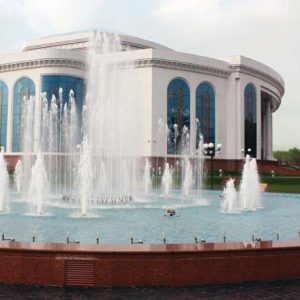 Electoral System
Electoral System
Citizens of the Republic of Uzbekistan have the right to elect and be elected to the representative bodies of state authority. Every voter has one vote. The right to vote, equality and freedom of expression of will are guaranteed by law.
The elections of the President of the Republic of Uzbekistan, to the Legislative Chamber of the Oliy Majlis of the Republic of Uzbekistan and Zhokarghy Kenes of the Republic of Karakalpakstan, to the representative bodies of state authority in regions, districts, cities and towns shall be held accordingly on the year of expiration of the constitutional term of their powers- on the first Sunday of the third decade of December. The elections shall be held on the basis of the general, equal and direct suffrage by secret ballot. Citizens of the Republic of Uzbekistan who have reached eighteen years of age have the right to elect.
Members of the Senate of the Oliy Majlis of the Republic of Uzbekistan are elected by secret ballot at relevant joint sittings of deputies of Zhokarghy Kenes of the Republic of Karakalpakstan, the representative bodies of state authority in regions, districts, cities and towns from among these deputies not later a monthly term after their election.
Citizens, who have been found by the court as those lacking active legal capacity, as well as persons serving their term, may neither elect nor be elected. Any other direct or indirect infringement on voting rights of citizens is inadmissible.
A citizen of the Republic of Uzbekistan may not simultaneously be a deputy in more than two representative bodies of state authority.
Judicial Power
The judicial power in the Republic of Uzbekistan functions independently from the legislative and executive power, political parties and other public associations.
The judicial system in the Republic of Uzbekistan consists of the Constitutional Court of the Republic of Uzbekistan, the Supreme Court of the Republic of Uzbekistan, the Higher Economic Court of the Republic of Uzbekistan, the supreme courts of the Republic of Karakalpakstan on civil and criminal cases, the Economic Court of the Republic of Karakalpakstan elected for the term of five years, regional and Tashkent city courts on civil and criminal cases, interdistrict, district and city courts on civil and criminal cases, martial and economic courts for the same term.
The Constitutional Court of the Republic of Uzbekistan hears cases relating to the constitutionality of acts of the legislative and executive powers and is elected from political and legal experts; it consists of the Chairman, Deputy Chairman and judges of the Constitutional Court including a representative from the Republic of Karakalpakstan.
The Chairman and members of the Constitutional Court may not be deputies.
The Chairman and members of the Constitutional Court may not be members of political parties and movements nor hold any other paid posts. The Supreme Court of the Republic of Uzbekistan is the supreme judicial body of civil, criminal and administration proceedings.
Acts, adopted by it, shall be final and binding throughout the territory of the Republic of Uzbekistan.
The Supreme Court of the Republic of Uzbekistan has the right to supervise the administration of justice of the supreme courts of the Republic of Karakalpakstan, regional, city, interdistrict, district and martial courts. Any economic and management disputes, that may arise between enterprises, institutions and organizations of various ownership, as well as between entrepreneurs, are settled by the Higher Economic Court and economic courts within their competence.
The term of office for judges is five years.
Cabinet of Ministers
The Cabinet of Ministers – the government of the Republic of Uzbekistan – is the executive power of the Republic of Uzbekistan, which ensures efficiency of economy, social sector and safeguards moral values, implementation of laws, others decisions of the Oliy Majlis, decrees and orders of the President of the Republic of Uzbekistan. The Cabinet of Ministers operates on the basis of the Law of the Republic of Uzbekistan “On the Cabinet of Ministers of the Republic of Uzbekistan”.
The Cabinet of Ministers heads the system of state administration bodies and its economic governance bodies, and ensures their coordinated work. The Cabinet of Ministers, in its work, is responsible before the President of the Republic of Uzbekistan and the Oliy Majlis of the Republic of Uzbekistan. The Cabinet of Ministers has the right of legislative initiative.
The Cabinet of Ministers is guided by the principles of collective leadership, democracy and the rule of law, interests of all nations and ethnic groups living in the Republic of Uzbekistan.
The Cabinet of Ministers issues resolutions and orders in accordance with the legislation, that are binding throughout the territory of the Republic of Uzbekistan and have to be executed by all bodies, enterprises, institutions, organizations, officials and citizens.
Normative decisions of the most critical decisions of the Cabinet of Ministers are adopted as resolutions of the Cabinet of Ministers.
Decisions of the Cabinet of Ministers relating to day-to-day work and on other current issues take the form of resolutions of the Cabinet of Ministers.
Decrees and resolutions of the Cabinet of Ministers are signed by the Prime Minister.
The Cabinet of Ministers controls the implementation of its decisions, either directly or through the ministries, state committees, departments and other bodies of state and economic management.
The normative resolutions of the Cabinet of Ministers are published in the Collection of the resolutions of the Government of the Republic of Uzbekistan, where needed they are delivered through mass media for immediate and nationwide disclosure.
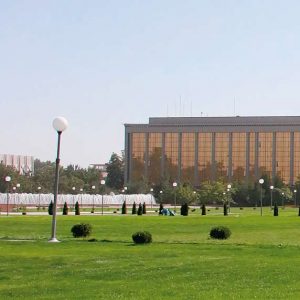 Local Governments
Local Governments
Councils of people’s deputies led by khokims (mayors) are considered to be representative bodies of Government in regions, districts, and towns (except towns with their district-based administration, as well as districts within towns). They act upon matters within their competence in accordance with the interests of the state and citizens.
The jurisdiction of local Governments includes:
- Rule of law, legal order and security of citizens;
- Economic, social and cultural development within their territories;
- Formation and implementation of the local budget, determination of the local taxes and fees, formation of non-budget funds;
- Management of the local utilities;
- Environmental protection;
- Registration of civil status acts;
- Adoption of normative acts and execution other powers which conform to the Constitution and laws of the Republic of Uzbekistan.
The khokim of the region, district and city heads the representative and executive power within the relevant territory. The khokim of region and the city of Tashkent is appointed and relieved of his/her post by the President of the Republic of Uzbekistan in accordance with the law.
The khokims of districts, cities and towns are appointed and relieved of their posts by the khokim of the relevant region and approved by the relevant Council of people’s deputies.
The khokims of city districts are appointed and relieved of their posts by the khokim of the relevant city and approved by the city Council of people’s deputies. The khokims of towns subordinate to district centers are appointed and relieved of their posts by the khokim of the district and approved by the district Council of people’s deputies. The term of office for the Council of people’s deputies and khokims is five years.
Culture and Art, Religion, Sport
Culture and Art
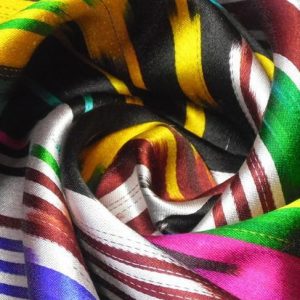 Culture of Uzbekistan is one of the brightest and original cultures of east. It is inimitable national music, dances and painting, unique national kitchen and clothes. The Uzbek national music is characterized as variety of subjects and genres. The songs and tool plays according to their functions and forms of usage can be divided into two groups: performed in the certain time and under the certain circumstances and performed at any time. The songs connected with customs and traditions, labor processes, various ceremonies, dramatized entertainment representations and games belong to the first group.
Culture of Uzbekistan is one of the brightest and original cultures of east. It is inimitable national music, dances and painting, unique national kitchen and clothes. The Uzbek national music is characterized as variety of subjects and genres. The songs and tool plays according to their functions and forms of usage can be divided into two groups: performed in the certain time and under the certain circumstances and performed at any time. The songs connected with customs and traditions, labor processes, various ceremonies, dramatized entertainment representations and games belong to the first group.
The Uzbek people is well-known for its songs. Koshuk – household song with a small diapason melody, covering one or two rows of the poetic text. The dancing character of a melody of this genre provides their performance in support of comic dances. “Lapar” is a dialogue-song. In some areas the term – lapar is applied to wedding songs “Ulan” (which is performed as a dialogue of man and women). Genre “yalla” includes two kinds of songs: a melody of a narrow range, and solo simultaneously with dance.
National and professional poems of the poets of east are used as the texts for the songs. The special place in the Uzbek musical heritage occupies “dastans” (epic legends with lyric-heroic content). Also “Makoms”– are the basic classical fund of professional music of oral tradition. The dances of Uzbeks distinguish softness, smoothness and expressiveness of movements, easy sliding step and original movements on a place and on a circle. The development of national painting began many centuries ago. At 16-17 centuries art of the manuscript and binding in Bukhara and some other urban centers has achieved significant success.
The decorating of manuscript included refined calligraphy, performance by water paints and thin ornaments on fields. In Samarkand and especially in Bukhara the Central Asian School of a miniature has achieved a great success and were developed many different style directions. One of them, for example is connected with traditions of Behzod, which characterized with its gentle style of writing the letter and architectural elements. The Uzbek national clothes of the end of XX centuries remain constant up these days. The men in that time carried a direct cover shirts, bottom and top dressing gowns. The dressing gowns were very light and made from cotton wool. There were cuts on each side of dressing gown for convenience at walking. The trousers were made wide, of direct breed lent from top to bottom. Female clothes: dressing gowns, dress, “parandja”– also of wide breed.
Culture, handicrafts and tourism are rapidly becoming inseparable partners. Local crafts are important elements of culture, and people travel to see and experience other cultures, traditions and ways of living. Crafts products form an important element of the purchases made by tourists, providing an important economic input to the local economy. Applied art of Uzbeks has a wealth of variety when it comes to style, materials and ornamentation. Silk, ceramics and cotton weaving, stone and wood carving, metal engraving, leather stamping, calligraphy and miniature painting are some genres passed down from ancient times. Back in the past, each region had its own cultural and ethnic traditions the unique features of which were established by local guilds that have strengthened these characteristics through their art.
Uzbek craftsmen nowadays still practice ancient jewelers making techniques for cutting gemstones, grain filigree, granular work, engraving and enameling, also they are trying to take into account fashion demands and styles. Embroidery is one of the most popular trends of applied arts in Uzbekistan. Every city of Uzbekistan has its own unique features such as ornamentation, composition, color range and stitching. The finest kind of embroidery, gold embroidery is still practiced in Bukhara. The art of carpet weaving is also a very ancient form of art throughout asia and the east, and nowadays it can be found in some of the cities of Uzbekistan today. The art of wood carving is used and adapted in modern interior design. Carved and painted tables, stools, caskets, pencil boxes and bookstands are popular pieces of furniture among local people and tourists. The art of Miniature painting and calligraphy has been revived again in its traditional form as well as some modern variants. For example miniatures stamped on leather, painted on paper miniatures, small lacquered boxes, framed pictures, pencil boxes and many other ideas skillfully painted by masters can be found in Uzbekistan.
Religious tolerance
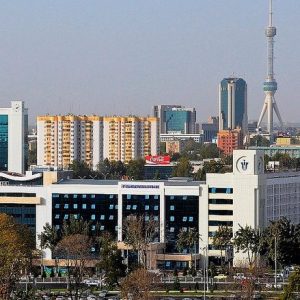 Progress of each country, as well as its position in the world community to be determined in first that how there lasting peace and harmony, as well spirit of tolerance. The policy of Uzbekistan, one of the Islamic Culture Centers of world is making on the groundwork of the interreligious and interethnic consent. Respect for other cultures, languages, religious beliefs and traditions as spiritual values are passed on from one generation to another over centuries. As early as Islamic renaissance, along with Muslim scientists the world science enriched and developed by the Christian and Jew scholars who worked at the famous academy of Mamun in Khorezm.
Progress of each country, as well as its position in the world community to be determined in first that how there lasting peace and harmony, as well spirit of tolerance. The policy of Uzbekistan, one of the Islamic Culture Centers of world is making on the groundwork of the interreligious and interethnic consent. Respect for other cultures, languages, religious beliefs and traditions as spiritual values are passed on from one generation to another over centuries. As early as Islamic renaissance, along with Muslim scientists the world science enriched and developed by the Christian and Jew scholars who worked at the famous academy of Mamun in Khorezm.
Uzbekistan being located at the center of the Great Silk road served as bridge between east and West during centuries. Well-known scientists and theologians as abu ali Ibn Sino (avicenna), Mukhammad al-Khorezmi, abu raykhon Beruni, akhmad al Ferghani, alisher Navoi, Mirzo Ulugbek, Imom Ismoil al Bukhari, Bakhauddin Nakshbandi and abdukholik Gijduvani, who born in holy Uzbek land made invaluable contribution to both world’s science and culture development and strengthen the dialogue and mutual understanding between nations. Peaceful coexistence of the various ethnics, cultures and religions here over centuries has determined religious tolerance of Uzbek people. Nowadays, tolerance, which brought up during centuries, was enriched with profound meaning and became an essential part of the social relations. peace, civil harmony, interreligious consent, equal participation of the various nations in social life is feature of the present Uzbekistan, the practice of which has a great value on strengthening and encouraging of the interconfessional and intercultural dialogue. To date over 130 nations of 16 confessions are living in the country.
Due to decisive and coherent actions on issues of interethnic relations and religion interethnic harmony and interconfessional cooperation became firmly established.
At the present time more than 2.250 religious organizations, representing 16 confessions officially registered in Uzbekistan. Moreover, religious is taught in Tashkent Islamic Institute, 10 madrasahs, Orthodox and protestant seminaries. The right of each person to religious belief is ensured by Uzbek Constitution and the Law on freedom of conscience and religious organizations. There are offered necessary conditions for legal equality, economic and social freedom of all citizens of the country without reference to their national origin and religious affiliation.
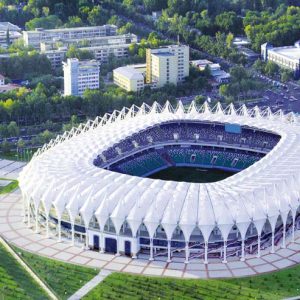 Sport
Sport
The sports team of the republic of Uzbekistan every year expands the numerical structure, winning more and more strong and high positions on international scene. Achievements of athletes of the country convincingly promote strengthening of authority of young republic on international scene. protecting colors of a national flag young men and girls, professionals of individual and game disciplines, showing at representative forums exclusive preparation and phenomenal skill, eloquently confirm, that they represent the country with rich sport traditions.
It is symbolical, that Uzbekistan does not drop out of the category of the countries where the understanding importance of this truth takes place. The governmental structures, public organizations, sport departments of the country always make common efforts in the solution of such important problems, as forward development of material base of sphere of sports and physical training, achievement of mass character in their organizations, strengthening of base of professional sector and others.
the Cabinet of Ministers of the republic for years of independence has accepted more than ten resolutions directed to the further development of sport by creation of new societies, construction of sport constructions, development of conditions for importance of this truth takes place. the governmental structures, public organizations, sport departments of the country always make common efforts in the solution of such important problems, as forward development of material base of sphere of sports and physical training, achievement of mass character in their organizations, strengthening of base of professional sector and others. The Cabinet of Ministers of the republic for years of independence has accepted more than tem resolutions directed to the further development of sport by creation of new societies, construction of sport constructions, and development of conditions for game in mini-football. By the most popular kind of sport in the republic is conducting Championship and Contests of Uzbekistan, the Cup of republic.
On mass character almost does not concede the sport “number one” the big tennis. Development of its base, no less than successes of tennis players of Uzbekistan, became regular by virtue of many reasons – to staginess, availability, between national popularity. the big tennis besides is under home nursing of the president of Islam Karimov, by the way, owning steady skills of game in it. Since 1994 in all large cities of the country the international tournaments with participation of the strongest tennis players of the world are annually carries out. And the main thing tennis derby capitals of the republic here some years are annual tournament “the Cup of the president”.
Competitors of its main trophy already became the strongest tennis players of the World, winners and participants of such prestigious international competitions, as “Challenger”, “Satellite”, and “Cup of Device”. The winner of “big Tashkent” invariable is celebrated itself by the head of the State…
The increasing popularity is won with the Open international female tournament “tayaKerep” which also collects rather representative circle of participants.
Uzbekistan periodically becomes a place of carrying out of such prestigious competitions and tournaments, as the Championship of Asia on boxing, the Championship of Asia and Oceania on taekwondo, the international tournament of a category “a” on free-style wrestling and others.
Every two year in capital of the country the international competitions are conducting on national struggle “Kurash” amir temura’s memories and hakim at-termezi. In 1999 the capital became a place of carrying out of the first World championship by this kind of national struggle against participation of athletes from 50 countries. Nowadays operates International association of Kurash which conducts purposeful work in interests of inclusion of the given kind of struggle in the program of Olympic Games. Preparation of sport reserve providing regularity on an axis “the beginner – the sportsmen of a professional class” has now system character. It is conducted by efforts of 522 youth sport schools, 63 specialized youth sports schools of an Olympic reserve, 5 schools of an Olympic reserve and 7 schools of the high sports skills. It is trained about 1500 starting sport talents in it from all regions of the republic… Special attention is given development of invalid sports in the republic. Expansion of its base became a subject of the directed actions not only for corresponding departments and public structures, but also Ministry of Social Welfare, and also the republican Society of invalids, regional representation of the International Red Cross.


